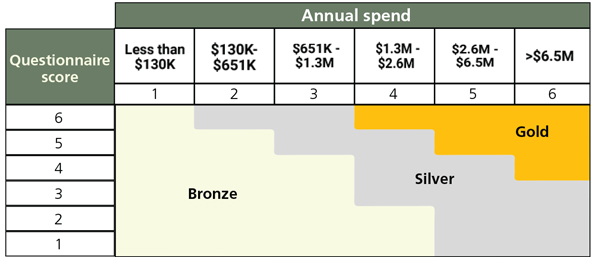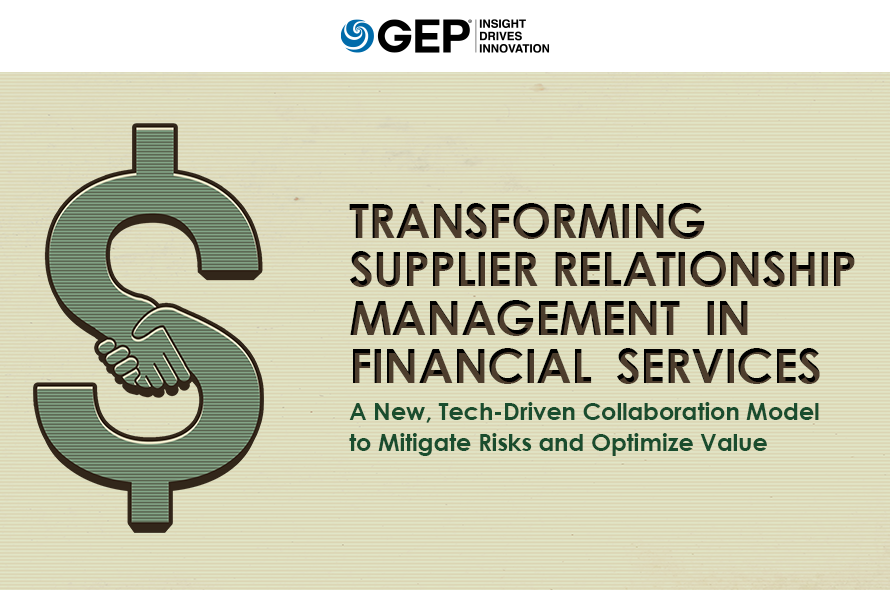Procurement leaders at financial services firms frequently take a very stringent approach to supplier relationship management (SRM), with practices driven by risk control and regulatory compliance. The rigidity of this approach can have crippling effects on the wider performance of procurement teams, who then struggle to justify the ROI on SRM programs.
This status quo is being challenged by procurement teams at market-leading financial services firms. In a new report, Transforming Supplier Relationship Management in Financial Services: A New, Tech-Driven Collaboration Model to Mitigate Risks and Optimize Value, experts from GEP share insights on disruptive factors in the industry and outline strategies for building high-performing SRM programs.
Inside This Paper:
- Envisioning a New Supplier Collaboration Model
- Defining SRM Scope and Designing a Solid Framework
- Enabling Transformation Using Unified Source-to-Pay Procurement Technology
A must-read paper for every procurement and supply chain leader in the financial services industry.
Procurement organizations across most industries are struggling to justify the return on investment (ROI) for supplier relationship management (SRM) programs. Financial services firms operate some of the most advanced and most stringent versions of these programs, with practices often driven by risk control and a highly regulatory environment. But there’s a danger for companies that operate in this way.
The danger lies in creating a precedent for a very rigid approach — one in which performance and commercial management take a secondary role. There’s a risk of SRM programs narrowly focusing on a limited number of suppliers and becoming a “tick-box” exercise for all others due to the significant manual effort required. This in return has crippling effects on the wider performance of procurement teams, with impacts ranging from the inability to bring in innovation from the outside world, to lengthy supplier selection timeframes, to clunky supplier onboarding processes — and ultimately to SRM teams not being able to justify their value.
Disruptive factors in the financial services industry are widening the gap between leaders — those that build and implement new supplier collaboration models — and followers who lag in this effort. We will be looking at the competitive advantage gained by the leaders, and discuss the actions aspiring leaders can take.

DISRUPTIVE FACTORS IN THE INDUSTRY
Over the past decade financial institutions came to grips with increased regulatory demands, globally. Some key focuses were technology and data management, regulatory reporting, and supplier risk.
Financial services SRM teams should respond effectively while staying aligned with their internal technology and risk teams. They need to look ahead and define technology implementation plans to embed appropriate measures with their suppliers. Last year, for example, financial institutions were negotiating new provisions into supplier contracts – only to experience varying degrees of success. Unless they follow a well-planned approach, their desired outcomes will require sustained effort over a longer period of time.
Market uncertainties and new entrants in the financial services sector are forcing financial services firms to focus on the “cost to serve,” leading to increased levels of outsourcing to combat rising cost pressures. Outsourcing pushes SRM teams toward adopting specific governance models. Financial services as a sector will continue to be heavily impacted by major political events such as Brexit and the H1B1 Visa Program in the United States. Consequently, financial services institutions will see their cost base increase as they set up outsourcing solutions, or other alternative structures.
The divide between market leaders and laggards will continue to increase. Some financial services organizations are actively testing and introducing innovative approaches, such as trials in cryptocurrencies by U.K. retail banks. Meanwhile, other organizations remain reticent to adopt cloud-based solutions. Rather than size, it is an organization’s risk appetite, culture and infrastructure that are the key drivers (or barriers) for driving value for customers and shareholders.
RECOMMENDATIONS FOR ASPIRING LEADERS
Create the vision for a new supplier collaboration model
Financial services organizations do not tap enough into innovative and cost-effective supply chains because they suffer from a rigid selection process. Procurement leaders who position their functions as capable of swiftly identifying, qualifying and implementing new vendors are generating interest from senior leadership. These leaders can build a strong case for a specialized SRM function within procurement by looking at SRM in its entirety and including SRM teams in the organization’s risk assessment program, thereby becoming a steward for the organization. Building the first line of defense — for example, by selecting the right suppliers — is the most effective measure, as it prevents risks from entering an organization.
Additionally, it is important to define the key performance indicators (KPIs) for the SRM team that align with the organization’s existing goals, and will also serve to move the organization further along the maturity curve. Some innovative KPIs include measuring spend addressed through continuous improvement programs; number of supplier- generated innovation ideas implemented by functional area; and knowledge transfer generated by vendors.
Build the foundations
Start with the fundamentals of SRM by designing a solid framework well understood by the business and applying it consistently across the supply base. Beginning with a small number of vendors with a good depth of activity will trigger more benefits than starting with many vendors with fewer activities. Set the expectation that the SRM program will evolve over time in scale, depth and frequency.
Ensure that the scope of SRM is clear and includes the fundamental pillars of risk, performance, commercial management, and reporting/governance as well as innovation. Create a clear RACI with distinct demarcation between SRM and service delivery. This allows procurement functions to focus on value-adding activities while the business retains day-to-day supplier management. Don’t underestimate the training and change management effort required when introducing new ways of working. Successful training approaches include role-based training by function and combining the new ways of working with the introduction of new tools.
Apply an initial segmentation to the supply base. Start by developing the supplier segmentation framework in collaboration with key partner functions such as risk and finance. Include, for example, assessment criteria across regulatory risk, use of personal and business sensitive data, reputational risk, financial loss, ease of switching, and spend. Right-size the various supplier segments based on the function’s initial bandwidth and bring more suppliers into the upper segments over time.

Illustrative Supplier Segmentation Output
Develop a list of activities with varying frequencies by segment. Compliance at the supplier level should be the main driver to ensure every activity is well-documented in a “control” or report that can demonstrate effective delivery of the activities. As an example, for review meetings, create a control requesting that documentation be stored in one central place, so as to demonstrate that the reviews were delivered in due time and were properly documented.
Example List of Controls and Evidence
Activities Control Evidence Conduct supplier segmentation using Supplier Segmentation Scorecard Segmentation for all suppliers has been completed Scoring matrix for the year is included in the profile of the supplier in the tool Conduct supplier review meetings Meetings have been delivered as planned, and all documentation has been completed All documentation uploaded on supplier profile Complete Supplier Performance Scorecard based on management information received and completion of review meetings Scorecard completed All supplier scorecards are filled in and submitted Complete the Supplier Risk Scorecard including financial stability, business continuity, use of data and quality assurance. Perform any additional financial checks, report and escalate as appropriate Financial checks have been performed according to supplier segment Finance scores are attached to the supplier profile with date. Suppliers below agreed financial score are marked at high risk and monitoring plan is in place Report benchmarking exercise Report on all supplier benchmarking results All benchmarking results collected and uploaded to supplier profile Agree on review timings and participants to review meetings All suppliers excluding lower tier have an annual plan for reviews in place Scorecards have been created and are attached to the profile of every supplier excluding lower tier Monitor certifications uploaded by supplier Certifications up to date All certificates up to date with documentation, sample audit of documentation Leverage digital transformation
Unified, source-to-pay procurement solutions should be seriously considered for automating SRM activities, allowing more to be done with more vendors and to drive greater insights. Through this approach, procurement organizations have been able to manage ten times as many vendors from a governance and reporting perspective.

Financial services firms in particular stand to benefit from this type of technology because it provides them with one common view of potential liabilities across the organization — for example, by creating 360-degree supplier views across spend, contracts, performance and risk. When audits or the regulator come along, technology allows the demonstration of risk control at the push of a button.
A unified solution also helps connect SRM with other pillars of the procurement operation, for example by automatically bringing incumbent insights and market intelligence into the supplier selection process. Additionally, source-to-pay platforms help to identify key relationships, such as by enabling internal surveys and supplier scoring to establish a single voice back from the organization. Other capabilities include accelerating the contracting process with the use of contract editing and e-signature functionalities, and creating user personas in the tool to keep information confidential and provide a user-friendly experience.
Collecting feedback from vendors on their use of your technology platform is important. Start with the creation of onboarding briefing materials and conduct plenty of briefing sessions. Once their initial reservations about using the platform have abated, suppliers benefit from systemization and automation. For instance, by using the platform, suppliers can gain the ability to self-report performance in a consistent manner. Measure and quantify process efficiencies gained by suppliers and help them to reallocate time and effort saved toward value-adding activities; for instance, the time saved in preparing performance reports can be used to work on cost-improvement initiatives.
THE TRANSFORMATION JOURNEY
In summary, the journey toward leadership in SRM is one of transformation and not of continuous improvement. It requires investment in technology and people. It also demands that organizations shift their vendor management culture and their perception of procurement’s added value. The immediate prize is reduced risk along with satisfied internal stakeholders and suppliers; but more importantly, a high-performing SRM program provides procurement teams with a framework to deliver sustainable value to the organization.


